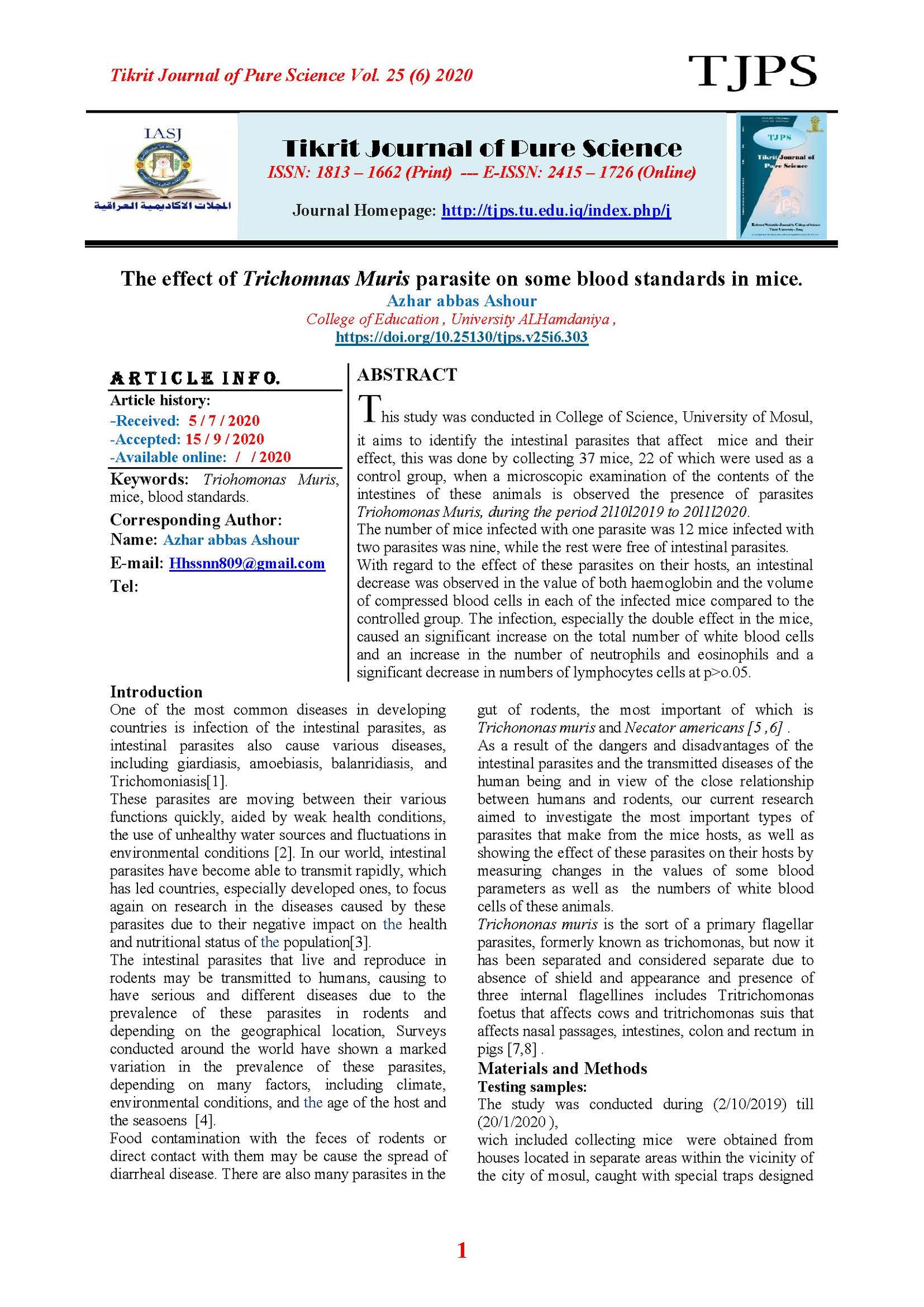The effect of Trichomnas Muris parasite on some blood standards in mice.
Main Article Content
Abstract
This study was conducted in College of Science, University of Mosul, it aims to identify the intestinal parasites that affect mice and their effect, this was done by collecting 37 mice, 22 of which were used as a control group, when a microscopic examination of the contents of the intestines of these animals is observed the presence of parasites Triohomonas Muris, during the period 2l10l2019 to 20l1l2020.
The number of mice infected with one parasite was 12 mice infected with two parasites was nine, while the rest were free of intestinal parasites.
With regard to the effect of these parasites on their hosts, an intestinal decrease was observed in the value of both haemoglobin and the volume of compressed blood cells in each of the infected mice compared to the controlled group. The infection, especially the double effect in the mice, caused an significant increase on the total number of white blood cells and an increase in the number of neutrophils and eosinophils and a significant decrease in numbers of lymphocytes cells at p>o.05
Article Details

This work is licensed under a Creative Commons Attribution 4.0 International License.
Tikrit Journal of Pure Science is licensed under the Creative Commons Attribution 4.0 International License, which allows users to copy, create extracts, abstracts, and new works from the article, alter and revise the article, and make commercial use of the article (including reuse and/or resale of the article by commercial entities), provided the user gives appropriate credit (with a link to the formal publication through the relevant DOI), provides a link to the license, indicates if changes were made, and the licensor is not represented as endorsing the use made of the work. The authors hold the copyright for their published work on the Tikrit J. Pure Sci. website, while Tikrit J. Pure Sci. is responsible for appreciate citation of their work, which is released under CC-BY-4.0, enabling the unrestricted use, distribution, and reproduction of an article in any medium, provided that the original work is properly cited.
References
[1] Abu-Zeid H. A.. Khan. M. U.. Omar M.S. and Al-Madani, A.A.(1998). Relationship of intestinal parasites in urban communities in Abha to socioenvironmental factors. Saudi. Med. J.10:477-480.
[2] Sobocinska M.K. (2019) Factors affecting the spread of Parasites in populations of wild European terrestrial mammals. Mamm Res.64(3):301-318.
[3] Belding, D. (1994) Textbook of parasitology. 3th ed.,Appleton-century-crcfts. Now york.
[4] Coles, E. H. (1986) Veterinary clinical pathology 4th ed., W.B, Saunders company, Philadelphia Amold. London. 652pp.
[5] Ichhpujani., R, L. and Bhatia, R. (1994) Medical parasitology. 1th ed.. Jay pee Braled Puble. new Delhi: 384p.
[6] Chao-Kuang H.(2015) Laboratory Animal Medicine,3th edu. Protozoa.sciencedirect.com.
[7] Sun. (1984) pathology and clinical features of parasitic diseases Masson publ.. Inc.. New York: 342pp.
[8] Zarei Z, Mohebali M, Khadijeh K, Motevllihaghi A, Heidari Z, Rezaeian M.(2018) Detection of Pseudocyst forms of Trichomonas muris in rodents from Iran.47(5):729-734.
[9] GarciaL. S.(2010) Practical Guid to Diagnostic Parasitology , 2nd.amazon.com.
[10]. Evatt. B. I., Gibbs. W,N, Lewis, S. M. and Me Arthur . J. R. (1992).
Fundamental diagnostic hematology, 2th ed., H.S. Dem. Of Health and
human services, Geneva: 68-74pp.
[11] Al-Rawi. Khusha Mahmoud Khalafallah. Abdulaziz Mohammed (1986). Design and analysis of agricultural experiments. Book House for Printing and Publishing, University of Mosul, 488 pages.
[12] Hempel P.S.(2009)Immune defence,parasite evasion strategies and their relevance for macroscopic phenomena such as virulence. Philos Trans R Soc Lond Biol Sci.364(1513):85-98.
[13] Rahimi M., Mohamma dzade T., Khanaliha K. (2018) Eosinophils and Parasitic Infections. Inter. J. Interic. Path.6(4):108-112.
[14] Pritchett-Corning K, Clifford CB.(2012)Parasitic infections of laboratory mice. Elsevier Ltd. ISBN. USA.
